Whether you’re passionate about rescuing puppies, feeding hungry people, or helping victims of a natural disaster, you’re considerably less likely to respond to a charity’s appeal for help if you receive it on your smartphone.
Three UConn Business-affiliated researchers verified that there is a substantial “mobile giving gap’’ between smartphone users and users of traditional computers; but they also discovered an easy and cost-effective solution.
“As most people know, charities fight hard for every consumer dollar, so an effective strategy is vitally important,’’ says marketing professor Stefan Hock, who conducted the research with Kelly Herd, an associate professor in the Department of Marketing, and recent alumna Kristen Ferguson ’23 Ph.D., now a professor at Notre Dame.
Their research, titled “The Mobile Giving Gap: The Negative Impact of Smartphones on Donation Behavior,’’ has just been published online by The Journal of Consumer Psychology.
The investigation of how consumers behave on their smartphones is of growing interest to marketers because the typical user now spends three hours and 15 minutes a day on the device. Furthermore, some 15% of the population no longer uses a traditional computer but conducts all business on a smartphone, Hock says.
Discovering the smartphone’s egocentric bias
The researchers had heard anecdotal evidence from charities, including many they spoke with in Connecticut, that their efforts weren’t getting strong responses on smartphones. Their first task was to figure out why.
“We wondered if it was because users had security concerns about donating through a smartphone. Or, maybe it was too difficult to process a donation using a hand-held device,’’ Hock says.

Through their research, Herd, Hock, and Ferguson discovered that consumers are more self-focused when using a smartphone. They process information and make different decisions than they would when using a traditional computer.
“The smartphone feels like a part of us, and we use it to focus on ourselves and our interests,’’ Hock says. “But charitable giving requires altruism and empathy. We tested our hypothesis with three studies, and it turned out to be the variable that explained the majority of the mobile-giving gap.’’
In their first study, the UConn researchers surveyed 232 individuals, with half participating on computers and the others using smartphones. The participants were paid a small sum for completing a survey, and then offered a small bonus which they could keep or donate to a local American Red Cross chapter.
More than 52% of those working on a computer donated the bonus sum to the Red Cross, but only about 34% of those using a smartphone did the same, confirming the egocentric nature of smartphone use.
In a second study, participants were asked if they wanted to donate a small bonus to the Salvation Army or keep it. That study also revealed a significant effect based on device type, with a lower percentage of participants on smartphones willing to donate. It also showed that participants were less focused on other people on their smartphones as opposed to PCs.
“We studied the Forbes Top 100 charities, and found that their ads were virtually identical, regardless of platform,’’ Hock says. “By using a one-size-fits-all approach, they are leaving money on the table.’’
“Most companies don’t seem to be adapting their materials to the smartphone user, except for the most minimal changes,’’ Herd says. “People think and act differently when they’re on a mobile device.’’
Charities don’t need to spend much to focus their campaigns
If the negative impact of smartphones on donation behavior occurs because individuals are less focused on other people, then highlighting other people in the call for donations might work, the team theorized. That’s exactly what the researchers tested in their final study, where they partnered with an alliance of German humanitarian-aid agencies. At the time of the Russian invasion of Ukraine, the organization was seeking aid for Ukrainian people and had employed a straight-forward appeal for financial assistance: We provide emergency help for the Ukraine – Donate Now.
The UConn team created a second advertising campaign that said: The people suffering in Ukraine need help – Donate Now.

With the new ad, the click-through rates were higher on smartphones, which served as a proxy of donation likelihood, thereby closing the mobile giving gap. “The ‘other-focused’ ad made all the difference because it drew people out of their smartphone self-absorption,” Hock says.
“We were able to close the mobile-giving gap with just a little tweaking of the original ad, and it was something that could be achieved without incurring additional expenses,’’ he says. “What we liked about our findings is that charities really don’t need to spend more money, and they don’t necessarily need to attract new donors.”
“Without creating a unique and ‘other-focused’ appeal to potential donors who are using smartphones, charities aren’t maximizing their fundraising potential,” Herd says. It is a donation strategy that can easily be implemented.
The nature of charitable giving is changing quickly. Online giving has grown by 42% since 2019 and mobile giving via smartphones grew to 28% of total donations in 2021, according to the research team.
“As a group, we were interested in understanding how the recent rise in mobile phone usage may impact charitable giving, a topic that is particularly pertinent in the wake of various ongoing global crises,’’ Ferguson says. “Through this research, our goal is to provide real, actionable insights to help charities increase donations by better understanding how to account for device type in their charitable appeals.’’
Although the researchers focused on charitable giving, their discoveries could have broader ramifications on other types of altruistic pursuits, such as recruiting volunteers, choosing to help the environment by recycling and addressing broad concerns about health and wellbeing.



